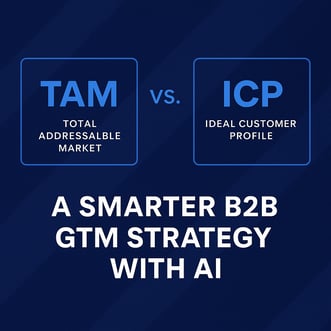Search has changed. Today's buyers use AI tools like Google's Search Generative Experience (SGE),...
TAM vs. ICP: A Smarter B2B GTM Strategy with AI
TAM vs. ICP: Why Understanding Both Is Critical to an AI-Era GTM Strategy
In today’s AI-fueled marketing world, it’s not enough to know who could buy from you. You need to know who will. That’s where TAM and ICP come in. Though often used interchangeably, these terms serve very different purposes — and mixing them up can derail your go-to-market (GTM) strategy.
Let’s break it down.
What Is a Total Addressable Market (TAM)? 
TAM is your theoretical maximum. It answers the question: If everyone who could possibly need my product actually bought it, how big would that opportunity be?
For example, if you sell AI-driven CRM tools to SaaS companies, your TAM might include every SaaS organization in North America with a sales team.
It’s big. It’s exciting. But it’s mostly hypothetical.
A common mistake: companies build marketing strategies around TAM, which leads to bloated budgets, vague messaging, and weak conversion rates. TAM is great for investor decks and long-term vision — not for daily pipeline generation.
What Is an Ideal Customer Profile (ICP)?
ICP is your filter. It defines the right-fit buyers within your TAM — the accounts most likely to buy, succeed, and grow.
A strong ICP might include:
- Mid-market SaaS companies
- Sales teams with 10–50 reps
- Complex buying committees
- A track record of experimenting with AI too
Good ICPs include filters like:
- Industry vertical
- Company size
- Tech stack
- Pain points
- Decision-maker roles
- Funding stage
- Business model (B2B vs. B2C, sales-led vs. product-led)
- Geography or compliance needs
- Organizational maturity
- Current GTM motion
A well-defined ICP sharpens campaigns, aligns sales development, AEs, and product marketing, and increases pipeline quality.
Key Differences Between TAM and ICP
Why GTM Teams Confuse Timing with Targeting
One of the most common GTM mistakes is confusing ICP traits with buying triggers.
ICP Traits = WHO
These are relatively stable attributes that define your best-fit customers.
Buying Triggers = WHEN
These are dynamic signals that suggest a customer might be ready now.
Common trigger events include:
- A new CMO or Head of Sales
- Recent funding round
- Expansion into new markets
- Job posts hinting at strategic shifts
- Changes to their tech stack
Triggers don’t redefine your ICP — they help you decide who to pursue first.
Using AI to Power Intent-Based GTM Strategy
When you combine TAM, ICP, and buying triggers, your GTM motion becomes:
- More efficient
- More aligned
- More scalable
AI can:
- Monitor your TAM for real-time changes
- Score and rank ICP-fit accounts
- Surface timing signals like executive changes or hiring trends
- Prioritize outreach based on likelihood to engage
TAM shows you who could buy.
ICP shows you who will buy.
Triggers tell you when to reach out.
Together, they form your GTM sweet spot.
5 Common TAM + ICP Mistakes (and How to Fix Them)
-
Targeting the full TAM - Your SDRs don’t need 10,000 accounts. They need the right 200.
-
Confusing traits with triggers - Triggers are timing-based. Traits are structural.
- Over-defining your ICP - Don’t box yourself out. Let the market refine your assumptions.
- Letting your profiles get stale - Your market evolves. Your segmentation should too.
- Misaligned teams - Sales chases "hot" leads. Marketing builds awareness. But both should aim at the same ICP.
Final Thoughts: Smarter Segmentation = Smarter Growth
TAM and ICP confusion is one of the top reasons revenue teams burn budget, chase the wrong leads, and miss their number.
At Sitera, we help B2B companies align their strategy around real ICPs, real triggers, and real-time intent. Our AI-first approach ensures your content, targeting, and outreach match how modern buyers — and their bots — make decisions.
Want to define your ICP or activate intent-based outreach? Let’s talk!
Frequently Asked Questions
What is the difference between TAM and ICP?
TAM, or Total Addressable Market, refers to all potential customers who could benefit from your product or service. ICP, or Ideal Customer Profile, is a smaller group of accounts that are most likely to buy and succeed with your solution.
Why should marketing campaigns focus on ICP instead of TAM?
Targeting your entire TAM often leads to wasted budget and low conversion rates. Focusing on your ICP helps ensure your messaging, targeting, and offers are aligned with high-probability buyers.
What are intent signals and how do they relate to ICP?
Intent signals are behavioral cues that suggest a buyer is actively researching or considering a solution. Your ICP defines who you should engage, and intent signals help you determine when they are most ready to hear from you.
How does AI improve how companies use TAM and ICP?
AI tools can analyze market data, monitor intent signals, and identify which ICP-fit accounts are showing buying behavior. This allows you to prioritize outreach based on likelihood to engage or convert.
.png?width=750&height=300&name=SITERA%20CONSULTING%20(Logo).png)


